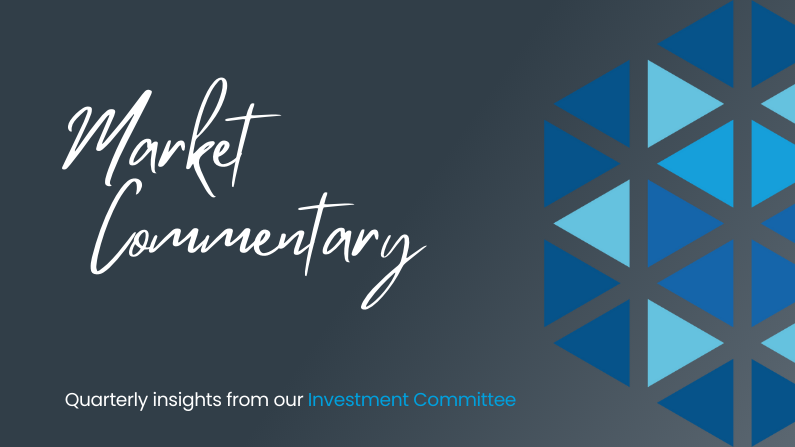CONVERGENCE
By, Steve Taddie, Peter Mueller, & the HC Investment Committee
Many forces converged in investment markets during the third quarter of 2023. Major economic issues included the omnipresent rhetoric/action of the central banks, rising oil/commodity prices, and higher long-term interest rates (10-year US Treasury). Higher long-term rates reflect the anticipation that the Fed will keep monetary policy tight for longer to effectively combat inflation, coupled with market concerns related to growing national debt levels. Adding to these pressures included another budget showdown, union “strike” efforts to secure higher pay rates and the pending resumption of student school loan payments. The latter impacts the direction and amount of disposable consumer spending, which is the backbone of the US economy. It has been a lot for markets to digest…
Globally, central banks are divided on monetary policy, with some banks lowering interest rates and others raising rates. The US and the EU are collectively signaling that they are at the top of their respective rate-tightening programs, with the US at 5.50% and the EU at 4.0%. At present, the combination of a rising Fed funds rate (short-term lending rate) and a falling US inflation rate creates a positive inflation-adjusted (real) interest rate here at home and a negative real interest rate in Europe. The real rate for the Fed funds rate is about +1.75% and will likely trend toward 2.00% by year-end, the most restrictive monetary policy stance in the US since 2007. In addition, the Fed shrunk its balance sheet by about $1 trillion, a much larger percentage reduction than the 2018-2019 tapering. The Fed is expected to continue shrinking its balance sheet through 2025, and the next $1 trillion will likely be tougher to shed than the first, as the US government will increase borrowing at a faster rate.
The budget showdown always consists of more grandstanding and partisanship than substance. We have been here so many times in the past, that the risk of shutdown appears to have minimal impact on markets. Historically, in the week leading up to a shutdown, markets have reacted negatively, only to rebound during the shutdown. The longer a shutdown continues, the less economic data becomes available, and the less reliable and accurate the data becomes. Given the current dysfunction in Congress, we may see this again in mid-November when the current short-term funding agreement expires.
The auto workers union’s push for higher wages and benefits led to strikes, which negatively impact the US economy. The ripple effect of a slowdown in auto production results in estimates between -0.05% and -0.10% negative impact on economic activity (as measured by GDP) for each week on strike. Historically, the economy tends to rebound quickly from strike-related GDP slowdowns, but the longer a strike or strikes last, the longer the recovery period.
Oil prices rose from $70 to about $90/barrel since mid-summer, translating to higher prices at the pumps and with combined higher commodity prices, slightly higher production costs. Energy price increases tend to cause a redistribution of retail spending, reducing overall economic activity.
With student loan payments restarting October 1, the $1.7 trillion of outstanding student debt is estimated to equate to $100 billion in loan payments. With these payments coming out of US consumer pockets, a redistribution of retail sales and a reduction in retail sales is inevitable.
The third quarter was challenging for investment markets. Commercial real estate, which serves as an anchor for other non-residential real estate investments, continues to face pressure, as office space demand has not recovered at the expected pace, resulting in some regions doing much worse than others.
In the bond market, interest rates rose about ¾ of 1% , taking the 10-year US Treasury yield to about 4.60%, the highest since 2007. The increase lowered bond prices a notch, but having a higher base rate on US Treasuries makes it harder to experience a significant interest rate induced loss on bond investments going forward.
The US stock market broke below the price support levels of its recent uptrend, with valuation compression serving as the behind-the-scenes culprit. For the quarter, stocks rose nicely in July, but the crosscurrents of the last two months pushed markets lower, finishing down about 3.6%. The drop below price support levels suggests that it may take some time for the market to regain its footing. On the upside, the lower market levels experienced during the third quarter helped reset investment expectations, which may lead to the market forming a new base to support the next advance. Furthermore, we are closing out the weakest seasonal part of the year and moving into the strongest (November to December).
While the current geopolitical and economic situation remains challenging, the market may be able to refocus on corporate earnings and other fundamentals that can help transition to a brighter economic and market picture into year end. Of course, this outlook is only viewed through an economic, market, and earnings lens. Geopolitical stress, violence, and suffering permeate the globe. We pray for humanity, that we may collectively rid the world of evil and move toward peace, cooperation, and community, aspirations of light and hope to strive for.
All the best,

Stephen J. Taddie, CBE® CFM

Peter Mueller, MBA, CFP®
For a downloadable version of this quarterly commentary click here.
The information provided here is general in nature and is shared for information purposes only; nothing herein should be interpreted as investment or tax advice. Any and all tax laws and/or specific tax rates referenced are subject to change. It should not be assumed that future performance of any specific investment or investment strategy will be profitable. Always consult your CPA/tax advisor/attorney (or reach out to us;) to discuss your specific situation. All investments carry the risk of loss, including the permanent loss of principal. Past performance is no guarantee of future results.

